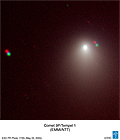Deep Impact’s arrival at Comet Tempel 1 should be spectacular. Due to reach the comet on July 4 of this year, the two-part probe will launch a 360 kg impactor designed to produce a crater on the comet’s nucleus and a plume of gas and dust. Getting inside a comet is a key mission goal: the ejected material should tell us much about the early days of the Solar System.
Right now astronomers are engaged in making baseline observations through Earth-based telescopes to characterize Tempel 1 as completely as possible. By examining its albedo (reflectivity), rotation period and size, the mission team will be able to differentiate between impact effects and the natural activity of the comet during the Deep Impact encounter.
 The photograph on the right (click to enlarge) shows an image of Tempel 1 together with a number of visual artifacts. What has happened here is that images were taken through various filters, one after the other. The motion of the comet against background objects accounts for the sequences of colored dots, which are actually two background stars. This image was created on the night of May 4-5 using the European Southern Observatory’s New Technology Telescope and the attached EMMI (ESO Multi-Mode Instrument). As seen here, the comet is 100 million kilometers (62 million miles) from Earth. The nucleus Deep Impact will hit is a 5 kilometer snowball hidden in the bright coma.
The photograph on the right (click to enlarge) shows an image of Tempel 1 together with a number of visual artifacts. What has happened here is that images were taken through various filters, one after the other. The motion of the comet against background objects accounts for the sequences of colored dots, which are actually two background stars. This image was created on the night of May 4-5 using the European Southern Observatory’s New Technology Telescope and the attached EMMI (ESO Multi-Mode Instrument). As seen here, the comet is 100 million kilometers (62 million miles) from Earth. The nucleus Deep Impact will hit is a 5 kilometer snowball hidden in the bright coma.
Image: A false-colour composite image of Comet Tempel 1 taken with EMMI on the ESO 3.5m New Technology Telescope, during the night of May 4 to 5, 2005. North is up, East is left; the field of view is 2.5 arcmin. Credit: European Southern Observatory.
From an ESO news release about Deep Impact:
The series of observations will provide unique clues to several questions related to comets. One will study in detail the chemical composition of the gas in the comet’s coma, looking for fresh material from the nucleus’ interior ejected during the impact. The careful study of this pristine material will provide important clues to trace the origins of comets, and so, on the formation of the solar system. The other series of observations will focus on the dust and boulders that should be released during the impact, thereby characterising the structure and composition of the nucleus. Astronomers should then finally know what these “dirty snowballs” are really made of.
The trick is that we really don’t know what will happen when the impact occurs. Shoemaker-Levy 9, the famous ‘string of pearls’ comet, provided quite a display when it struck Jupiter in 1994, but the part of Deep Impact that will hit Tempel 1 is hardly in that league. Most models predict a crater the size of a football stadium, with an associated plume of gas and dust, but there is always the possibility that the comet will simply swallow the impactor, leaving little to observe, or that the cometary nucleus will eventually break up.
Meanwhile, NASA reported Deep Impact’s second trajectory correction maneuver of the mission, a 95-second burn executed on May 4. The 1 meter long impactor should strike the comet at 6.3 miles per second (37,100 kilometers per hour). The flyby spacecraft will monitor the event from 500 kilometers (310 miles). Four data collectors aboard the flyby craft will record the effects of the collision, even as a duplicate medium resolution instrument onboard the impactor records the last moments before it is destroyed.
NASA’s Deep Impact site is here, and ESO also offers coverage. As of May 31, Deep Impact was 30.22 million kilometers away from the comet.

